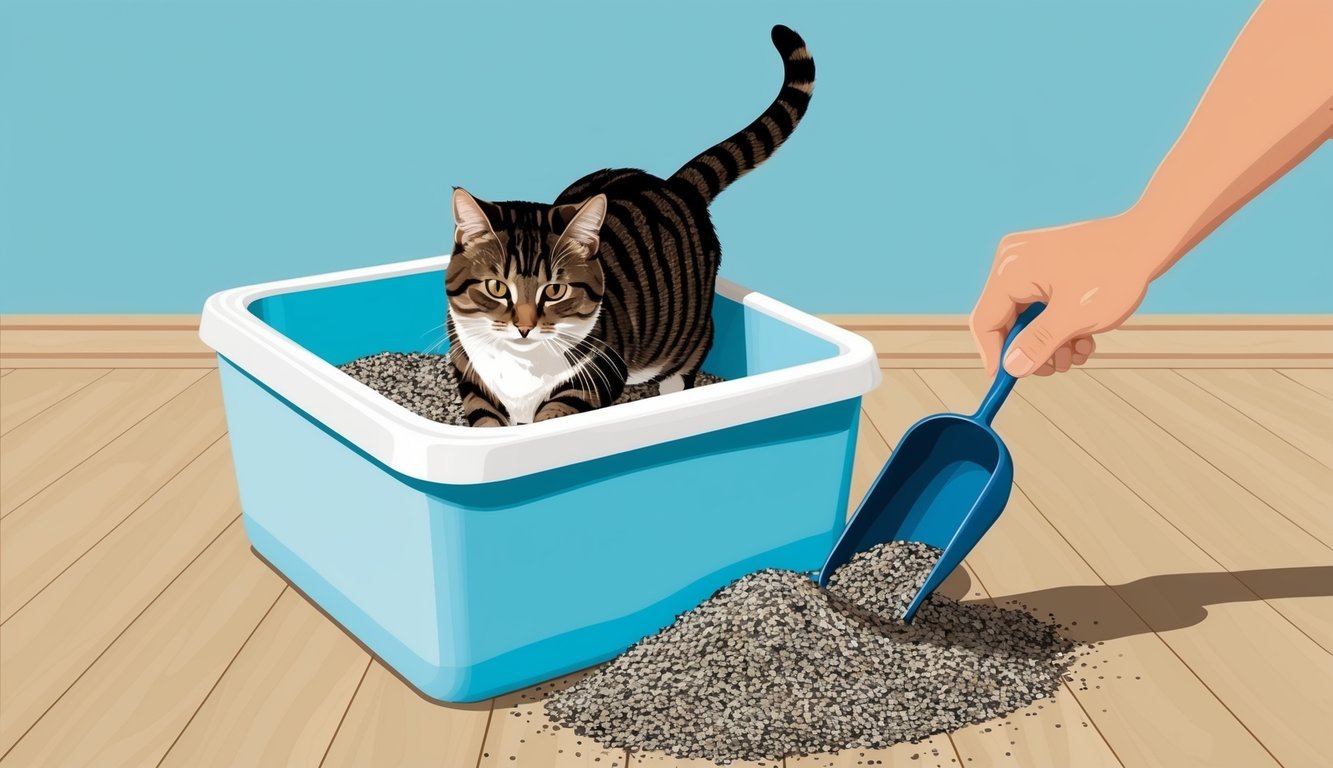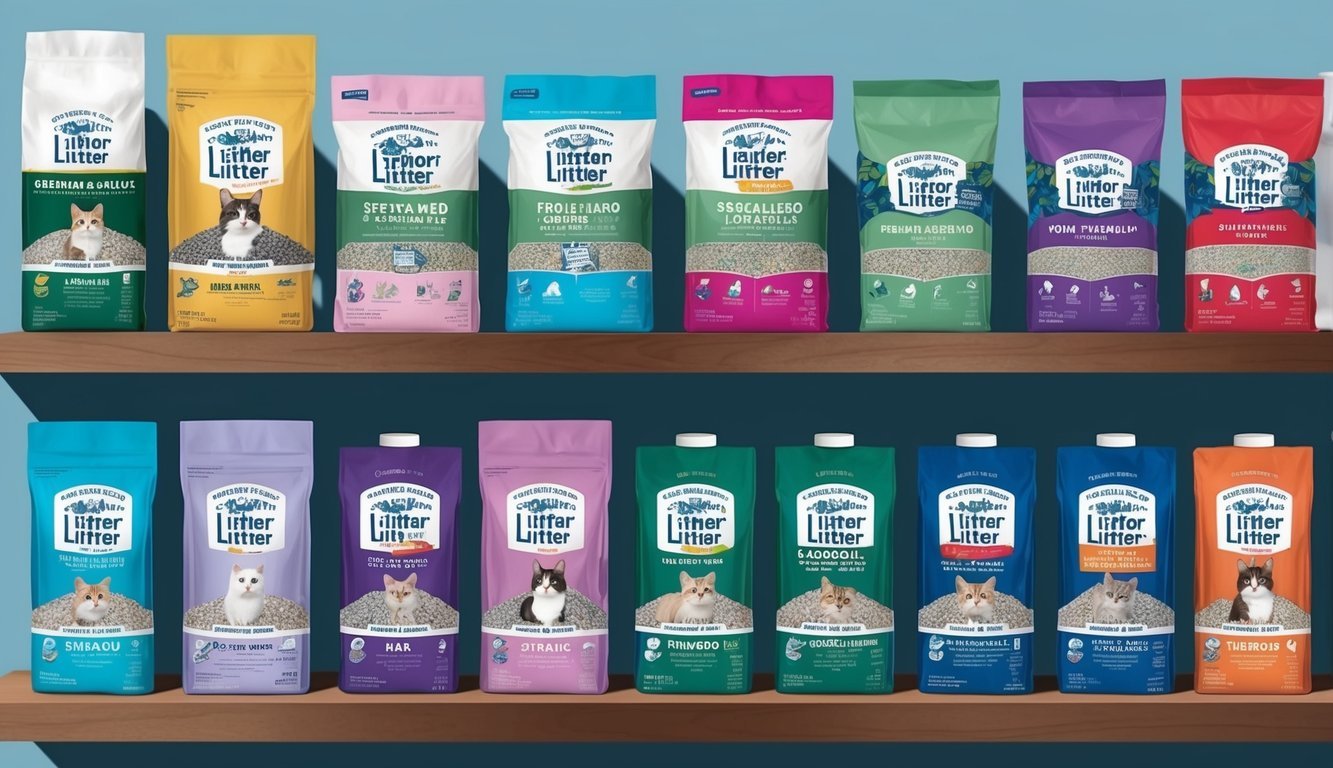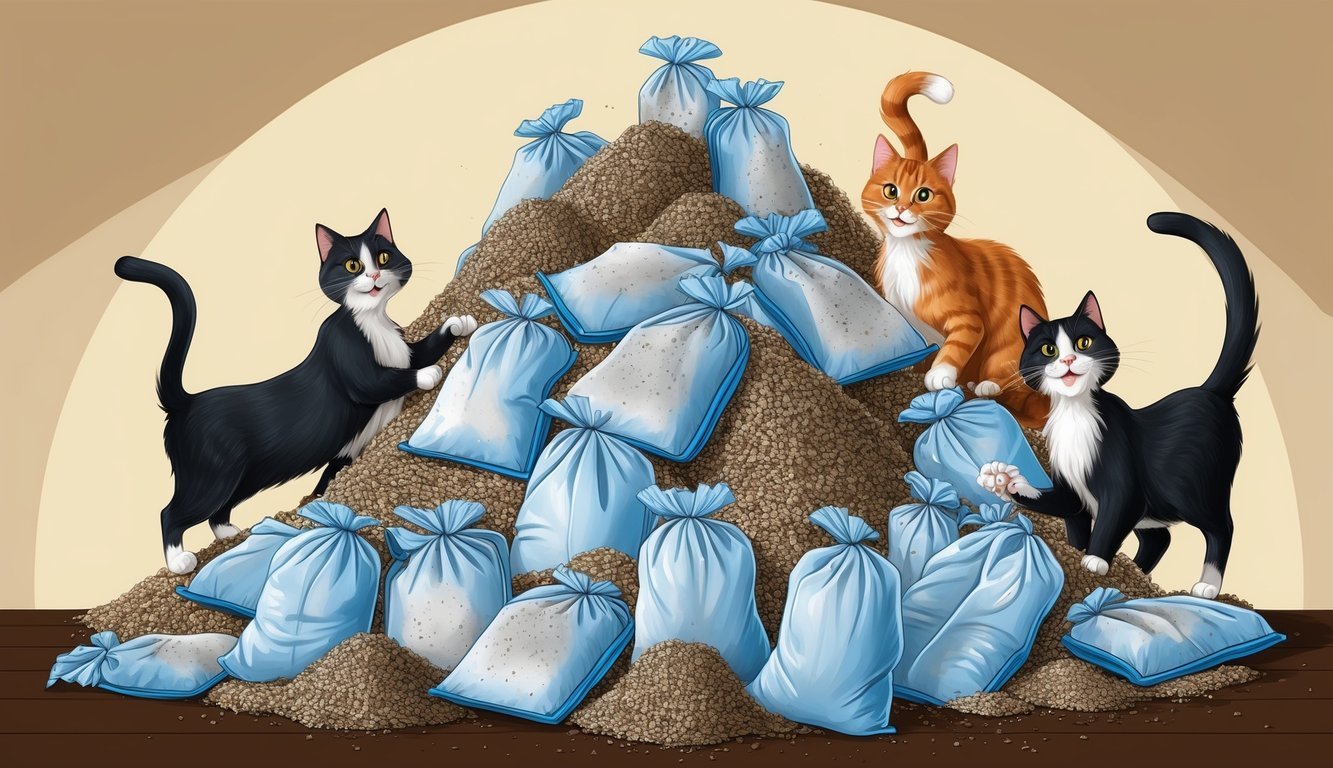Choosing the right litter for your cat can make a significant difference in their comfort and health.
High-quality cat litter not only helps manage odors but also supports your cat’s natural instincts and hygiene.
With so many types available, from clumping clay to biodegradable options, you must find one that suits both your and your pet’s needs.
Different litters offer various benefits, impacting everything from how often you clean the litter box to your cat’s overall satisfaction.
You may be surprised by how certain features, like low dust or specific materials, can enhance your cat’s litter experience.
Engaging with the right litter can lead to a happier cat and a fresher home.
Let’s explore the many options available, the features that matter, and how to pick the perfect litter to keep both you and your cat content.
Discover what works best for you in this guide!
Key Takeaways
- Selecting the right litter enhances your cat’s comfort and health.
- Features like clumping ability and dust control are crucial for your cat’s satisfaction.
- Regular management can lead to a cleaner home environment and a happier pet.
Understanding Cat Litter Basics
Choosing the right cat litter can significantly improve your pet’s bathroom experience and your home environment.
Different types of litter offer unique benefits and drawbacks, so it’s essential to understand your options and what might suit your cat best.
Types of Cat Litter
There are several types of cat litter available, each designed for specific needs.
-
Clay Litter: The most common type, available in two forms:
- Clumping: Binds moisture and forms solid clumps for easy cleaning.
- Non-Clumping: Absorbs moisture without forming clumps, making it less convenient.
-
Silica Gel Litter: Made from tiny silica crystals that absorb moisture and control odors. It lasts longer but can be more expensive.
-
Natural Litter: Options like corn, wheat, tofu, paper, and walnut are biodegradable. They are great for environmentally conscious cat owners and often more gentle on sensitive paws.
-
Crystal Cat Litter: Similar to silica gel, these crystals absorb moisture and control odors effectively.
Each type has its pros and cons regarding tracking, dust levels, and odor control.
Choosing the Right Litter for Your Cat
When selecting litter, consider your cat’s preferences and any potential allergies.
- Dust Levels: If dust is a concern, look for dust-free options, which are less likely to irritate you or your pet’s respiratory system.
- Tracking: Some litters stick to your cat’s paws and get tracked around the house. Clumping litters tend to have less tracking compared to non-clumping ones.
- Odor Control: Look for litters labeled as unscented or fragrance-free, especially if your cat is sensitive to strong smells.
You might need to experiment with different types to find what your cat prefers.
Familiarizing yourself with these factors will help make the litter box a more pleasant place for both you and your pet.
The Impact of Litter on Cat Health
The type of litter you choose can significantly affect your cat’s health.
It’s essential to understand how different products may influence respiratory health and contribute to allergies or sensitivities.
Respiratory Health and Litter Dust
Dust produced by cat litter can pose serious respiratory risks for your cat.
Certain traditional litter types generate excessive dust when your cat digs.
This dust may lead to irritation and respiratory problems, especially in older cats or those with pre-existing conditions.
Choosing low dust or dust-free options can help minimize these risks.
Natural cat litters and biodegradable products are often formulated to produce less dust.
Brands promoting low dust levels can make a noticeable difference in your home’s air quality.
Monitor your cat for signs of respiratory distress—persistent coughing, sneezing, or labored breathing could all indicate issues related to litter dust.
Ensuring proper ventilation in the litter area also helps maintain a healthier environment.
Allergies and Sensitivity
Some cats develop allergies or sensitivities to specific litter materials.
Common issues include skin irritation or respiratory problems, which can stem from exposure to synthetic fragrances or certain clay types.
When selecting litter, it’s beneficial to consider hypoallergenic options.
Natural or biodegradable materials often contain fewer irritating chemicals.
Monitor your cat’s reaction when changing litter brands, as abrupt changes can also lead to stress or discomfort.
If you notice any signs of allergies, such as excessive grooming or skin problems, consult your veterinarian.
They can help identify the triggers and suggest suitable alternatives for your cat’s litter.
Making informed choices can promote better health for your furry friend.
Litter Box Essentials
When it comes to litter boxes, proper placement and maintenance are key.
The innovations in litter boxes also provide options that can simplify your routine and enhance your cat’s comfort.
Here’s what you need to know to ensure a better experience for you and your feline friend.
Proper Placement and Maintenance
Choosing the right location for your litter box is crucial.
Place it in a quiet, low-traffic area where your cat feels safe.
Avoid placing it near food and water bowls to maintain hygiene.
Regular maintenance is equally important.
Scoop the litter daily and completely change it at least once a week.
Consider using a quality litter that clumps well, making cleanup easier.
Liner options can also keep the box cleaner for longer.
Look for heavy-duty liners that can withstand your cat’s digging without tearing.
They make it easier to dispose of waste and keep the litter box from adhering to the bottom.
Innovations in Litter Boxes
Modern litter boxes have come a long way.
Automatic litter boxes can simplify your cat care routine significantly.
They self-clean after each use, reducing the hassle of regular maintenance.
These boxes often come with sensors to detect when your cat has used them, activating the cleaning cycle afterward.
Features like odor control and waste compartments help keep your home smelling fresh.
Some boxes also include deodorizing technology, which keeps odors at bay without the need for added sprays or powders.
If you prefer a more traditional approach, look for litter boxes designed for optimal airflow, which can help dry waste and minimize smells.
Investing in one of these innovations can greatly improve your litter box experience.
Advanced Litter Features
When selecting cat litter, you’ll want to consider the various advanced features that enhance odor control and improve clumping ability.
These elements significantly impact your experience with litter maintenance and your cat’s comfort.
Odor Control Mechanisms
Effective odor control is crucial for a pleasant home environment.
Many modern litters incorporate advanced mechanisms like activated charcoal and baking soda, which help neutralize odors.
- Activated Charcoal: This ingredient traps and eliminates odors, ensuring your litter box remains fresh. It’s particularly beneficial for households with multiple cats.
- Baking Soda: Another common addition, baking soda combats strong smells naturally and is safe for your pets.
For instance, Fresh Step Advanced Clumping Litter features a proprietary formula designed for maximum odor protection.
With its dual-action approach, odors are fought on contact and continue to be controlled over time.
This can significantly reduce the frequency of litter changes.
Clumping Factors
Clumping ability is essential for easy scooping.
High-quality clumping clay cat litter, such as Dr. Elsey’s Ultra Unscented, forms tight clumps that are easy to remove.
- Clumping Clay: Look for litters made from sodium bentonite, a natural clay that absorbs moisture and clumps together quickly.
- Easy Scooping: When litters form strong clumps, it minimizes waste and reduces odor retention in the remaining litter.
A good clumping litter not only helps keep odors at bay but also simplifies maintenance.
Strong, compact clumps mean less mess during cleaning sessions, so you can spend more time enjoying your pet and less time managing litter box duties.
Litter for Specific Needs
Choosing the right cat litter can vary based on your household dynamics and values.
Understanding your specific needs, like having multiple cats or wanting eco-friendly options, helps you make the best choice for your furry companions.
Multi-Cat Households
If you have several cats, consider using clumping litter designed for heavy use.
Clumping litter absorbs moisture and forms solid waste clumps, making it easier to clean.
Products like Tidy Cats 24/7 Performance are particularly praised for their superior clumping ability and long-lasting odor control.
For multi-cat households, you may also want to consider the size of the litter box and the number of boxes.
A general rule is one box per cat plus one extra.
This can help reduce territorial disputes and keep your home fresher.
Eco-Friendly and Biodegradable Options
If sustainability is important to you, consider eco-friendly options made from recycled materials.
Biodegradable cat litters use ingredients like corn, wheat, or paper and break down naturally.
Brands like Ökocat and World’s Best Cat Litter offer excellent choices that are compostable and safe for the environment.
These options often produce less dust, which is great for cats and owners with allergies.
They still provide good odor control and clumping abilities while being gentle on the planet.
Always check for certifications to ensure they meet your environmental standards.
Non-Clumping Varieties
While clumping litter is popular, non-clumping options can also be effective, especially for certain situations.
Non-clumping litter absorbs moisture but doesn’t form clumps, making it an easy cleanup option for those who prefer frequent changes.
Materials like clay or wood pellets are common in non-clumping varieties.
Brands like Dr. Elsey’s Cat Attract are recommended for their ability to control odors without the clumping action.
This variety may suit older cats or those not used to litter boxes.
Each type of litter has its pros and cons, so evaluate your cat’s preferences and any specific requirements you may have.
Tips and Tricks for Litter Management

Managing cat litter effectively can enhance both your and your cat’s experience.
From minimizing litter tracking to making scooping easier, these practical tips will help streamline your routine.
Reducing Litter Tracking
Litter tracking is a common frustration for cat owners.
To minimize it, consider using a litter mat that catches debris as your cat exits the box.
These mats can effectively trap litter particles, making cleanup much easier.
Top-entry litter boxes are another great option.
They require your cat to jump in from above, which can reduce the amount of litter that escapes.
Ensure the box is spacious enough for your cat’s comfort.
Additionally, using a low-dust litter can help prevent particles from flying out when your cat digs.
Look for clumping types designed to reduce tracking, which can keep your floors cleaner.
Making Scooping Easier
A clean litter box is essential for your cat’s health, and scooping regularly is a key part of that maintenance.
Choose a scoop with a wide head and long handle.
This design makes it easier to remove clumps without missing any bits.
Try to scoop the litter at least once a day.
This prevents odor buildup and keeps your cat happy.
For added convenience, consider a self-cleaning litter box if you prefer less frequent scooping.
Also, maintain an optimal litter depth of about 2 to 3 inches.
This allows your cat to dig and bury waste effectively without creating excessive mess.
Transitioning to New Litter Types
Changing your cat’s litter can sometimes be challenging.
To make the transition smoother, start by mixing the new litter with the old one.
Begin with a small ratio of new litter—about 25%—and gradually increase it over 7 to 10 days.
Pay attention to your cat’s behavior during this period.
If they seem hesitant, try adjusting the mixture or offering an additional box.
Choose a litter that matches your cat’s preferences.
For instance, if they enjoy clumping litter, ensure the new type has similar qualities.
Scent also plays a role: many cats prefer unscented options, so consider that when making a switch.
Popular and Specialized Litter Products

When it comes to choosing the best litter for your cat, there are various options catering to different needs.
Understanding popular brands and innovative materials can help you make an informed choice for your feline friend.
Top Picks for Cat Litters
-
Tidy Cats 24/7 Performance: Known for its excellent moisture-locking technology, this clumping clay litter provides long-lasting odor control. It is often recommended by veterinarians for its reliability.
-
Dr. Elsey’s Ultra Unscented: This litter is designed to minimize dust and provide superior clumping. It’s a great choice if you’re looking for odor control without added fragrances.
-
PrettyLitter: This specialized litter changes color based on your cat’s pH levels, helping you monitor their health. It’s low in dust and offers excellent absorption.
-
Fresh Step Advanced: This litter combines clumping ability with activated charcoal to neutralize odors, making it a popular choice among cat owners.
These options cover a range of concerns, from clumping ability to odor control and health monitoring.
Innovative and Specialized Litters
Innovation in cat litter has resulted in specialized products that cater to unique needs.
-
Silica Gel Litter: This type absorbs moisture and controls odors without clumping. It lasts longer than traditional litters and is low in dust, making it a good option for sensitive cats.
-
Ökocat Dust Free Non-Clumping Paper Pellet: Made from recycled materials, this litter is biodegradable and dust-free. It may take some time for your cat to adjust, but it offers a gentle alternative.
-
Activated Charcoal Litter: Known for its great odor control, this litter effectively neutralizes smells while maintaining clumping properties.
Choosing the right litter involves considering both functional aspects and your cat’s comfort.
Frequently Asked Questions

When it comes to litter for your cat, several common queries often arise.
You may wonder about odor control, litter preferences, and differences between types of litter.
Let’s explore these topics to help you make the best choices for your feline friend.
What’s the top cat litter for odor control?
For effective odor control, look for litters made from clumping clay, especially those with activated charcoal.
These types trap moisture and odors, keeping the box fresher.
Some natural options, like pine or corn-based litters, also provide decent odor absorption.
How can I tell if a cat litter is clump-worthy or not?
A quality clumping litter will form tight, solid clumps when wet, making it easy to scoop out waste.
Look for products labeled as “clumping.”
You can test the litter by adding a small amount of water; good clumping litter will hold together instead of breaking apart.
Do cats have a litter preference, and how can I find out?
Yes, cats often have individual preferences for litter texture, scent, and brand.
To find out what your cat prefers, you might need to try a few different types.
Observe how your cat reacts each time you switch litter; comfort and location also play crucial roles.
What’s the scoop on eco-friendly cat litters, are they any good?
Eco-friendly litters can be great alternatives to traditional clay-based products.
Many options are made from recycled materials or natural substances like corn, wheat, or paper.
They may vary in clumping ability and odor control, so read reviews and try them out to see what works for you.
Any tricks for keeping the litter box fresh longer?
To keep the litter box smelling fresh, scoop it daily and replace the litter every week or two, depending on use.
Regular cleaning of the box itself with mild soap and water is also important.
Additionally, consider placing the box in a well-ventilated area.
Is there a difference between clumping and non-clumping litter?
Yes, clumping litter forms solid clumps when a cat urinates, making it easier to remove waste.
Non-clumping litter absorbs moisture but does not form clumps.
Clumping litter usually requires less frequent changing and simplifies maintenance, while non-clumping can be more absorbent in some cases.


